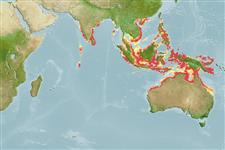>
Eupercaria/misc (Various families in series Eupercaria) >
Haemulidae (Grunts) > Plectorhinchinae
Etymology: Plectorhinchus: Greek, plektos = plaited + Greek, rhyngchos = snout (Ref. 45335).
More on author: Bleeker.
Environment: milieu / climate zone / depth range / distribution range
экология
морской ассоциированный с рифами; пределы глубины 5 - 40 m (Ref. 90102). Tropical; 22°N - 25°S, 72°E - 153°E
Indo-West Pacific: west coast of India; Philippines and Indonesia to Papua New Guinea, south to northern Australia (Ref. 9710).
Size / Вес / Возраст
Maturity: Lm ? range ? - ? cm
Max length : 50.0 cm TL самец/пол неопределен; (Ref. 48635)
колючие лучи спинного плавника (общее число) : 12 - 13; членистые (мягкие) лучи спинного плавника (общее число) : 19 - 22; колючие лучи анального плавника: 3; членистые (мягкие) лучи анального плавника: 7 - 8. This species is distinguished by the following characters: chin with 6 pores, no median pit; gill rakers on first gill arch 7-9 + 1 + 17-20 = 26-29; Dorsal XII (rarely XIII), 19-22, 3rd-5th spines longest; lips fleshy, moderately swollen with age; scales ctenoid (rough to touch); lateral line tubed scales about 54-60; body depth 2.6-2.9 in SL; caudal fin rounded to slightly emarginate. Colour: brown to yellowish grey with 5 to 9 fairly narrow grey or white longitudinal stripes outlined with dark brown on body and continuing around snout; fins yellow, soft dorsal, caudal, and pectoral fins with darker stripes disappearing with age; eye and lips yellowish; mouth, tongue, and gill rakers scarlet; chin white; juveniles have fins striped and fewer stripes on body (Ref. 47695, 90102).
Occurs on coastal and seaward reefs. Adults on deep, current-prone slopes with rich invertebrate growth; juveniles on sheltered reefs nearby (Ref. 48635). Found singly, in small groups under ledges or large resting aggregations by day, forages for small invertebrates at night (Ref. 9710, 90102). Caught throughout its range; not common. Rarely marketed in India (Ref. 3412). Taken by handline and spear. Marketed fresh, a small quantity is salted (Ref. 47695).
Life cycle and mating behavior
половая зрелость | размножение | нерест | икра | Fecundity | личинки
Oviparous, distinct pairing during breeding (Ref. 205).
McKay, R.J., 1984. Haemulidae. In W. Fischer and G. Bianchi (eds.) FAO species identification sheets for fishery purposes. Western Indian Ocean (Fishing Area 51). Vol. 2. FAO, Rome. pag. var. (Ref. 3412)
Статус Красного Списка МСОП (Ref. 130435: Version 2024-1)
Угроза для людей
Harmless
Использование человеком
рыболовство: коммерческий
дополнительная информация
инструменты
Специальные отчеты
Скачать в формате XML
ресурсы в Интернет
Estimates based on models
Preferred temperature (Ref.
123201): 27 - 29.3, mean 28.7 °C (based on 1858 cells).
Phylogenetic diversity index (Ref.
82804): PD
50 = 0.5000 [Uniqueness, from 0.5 = low to 2.0 = high].
Bayesian length-weight: a=0.01820 (0.01098 - 0.03017), b=3.01 (2.87 - 3.15), in cm total length, based on LWR estimates for this species & Genus-body shape (Ref.
93245).
Trophic level (Ref.
69278): 4.0 ±0.66 se; based on food items.
устойчивость к внешним воздействиям (Ref.
120179): средний (среднего размера), минимальное время удвоения популяции 1.4-4.4 года (Preliminary K or Fecundity.).
Fishing Vulnerability (Ref.
59153): Moderate vulnerability (40 of 100).
Nutrients (Ref.
124155): Calcium = 33.7 [12.0, 63.5] mg/100g; Iron = 0.51 [0.27, 0.96] mg/100g; Protein = 19.5 [17.7, 21.3] %; Omega3 = 0.134 [0.073, 0.216] g/100g; Selenium = 30.9 [18.2, 52.3] μg/100g; VitaminA = 81.8 [33.1, 199.7] μg/100g; Zinc = 0.995 [0.688, 1.473] mg/100g (wet weight);
